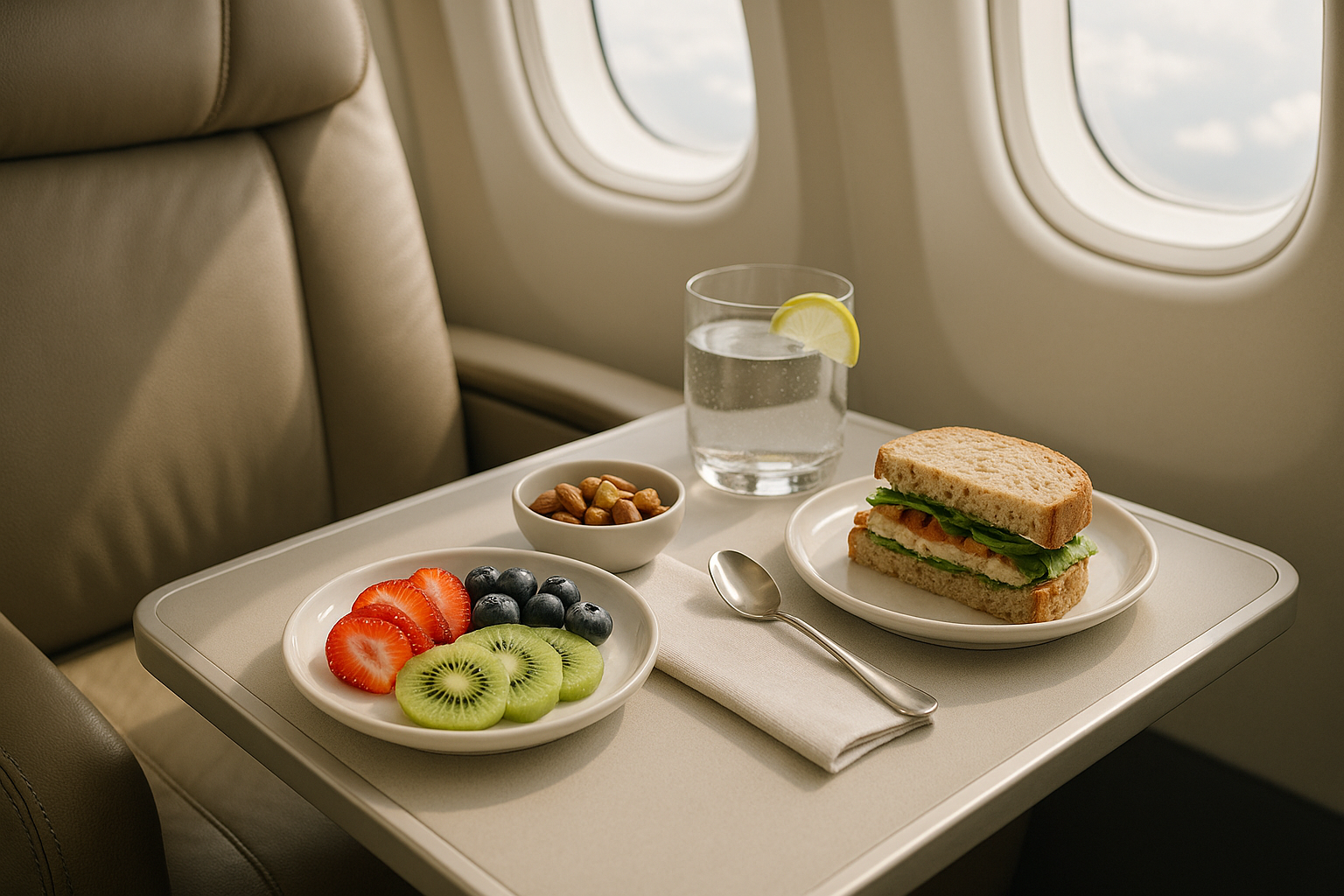The hours can stretch out before you like an unending horizon. But what if the key to transforming these seemingly endless hours lies within your carry-on bag? Yes, we’re talking about snacks! Not just any snack, but specially crafted minimalist treats designed to elevate your in-flight experience. In this comprehensive guide, we delve into the concept of “Sky-High Snacking: Minimalist Treats for Long-Haul Flights”.
The importance of well-curated, nutritionally balanced, and satisfying snacks during long-haul flights cannot be overstated. Whether you’re a frequent flyer or an occasional traveler, the food you consume mid-air can significantly influence your in-flight comfort and overall travel experience. In fact, snacking smart can help fend off jet lag, maintain hydration, and ensure your energy levels don’t plummet. But with limited options available on-board, what should you pack for a healthier and more enjoyable flight? That’s where our guide comes in.
Unpacking the Concept of Minimalist Treats
Minimalist treats are all about simplicity and quality, encompassing nutrition-packed bites that are easy to pack, convenient to eat, and most importantly, tasty. These treats aim to meet your nutritional needs while avoiding unnecessary additives, excess sugar, and unhealthy fats. Minimalist snacking in the sky is not just about eating to curb hunger; it’s about nourishing your body, fueling your brain, and uplifting your mood in a confined space where your choices are restricted.
What to Expect from This Guide
By the end of this extensive guide, you will be equipped with a better understanding of the role and benefits of minimalist treats during long-haul flights. We will unveil the science behind minimalist snacking, exploring how certain food types can benefit your body at high altitudes. Additionally, you’ll gain insights into the principles of assembling a minimalist snack pack, focusing on optimal nutritional balance and taste, but without the unnecessary calorie load.
The guide will further provide practical tips for selecting the right containers, maintaining food safety standards, and adhering to airline regulations. From protein-rich edibles that keep you satiated, hydrating fruits and veggies, to compact energy bars and antioxidant-rich dark chocolate, we will delve into an array of minimalist snack options suitable for long-haul flights. We will also touch upon the significance of staying well-hydrated in-flight, spotlighting some of the most hydrating (and least dehydrating) beverages.
The goal is not just to survive the flight, but to arrive at your destination feeling refreshed and revitalized. By the time you finish this guide, you will have a clear roadmap for assembling your minimalist snack pack, along with practical tips for enjoying an elevated snacking experience in the sky. So, sit back, relax, and let’s embark on this journey to sky-high snacking.
Demystifying Sky-High Snacking: The Art and Science
Have you ever pondered why airplane food often lacks the same zest and flavor you’re accustomed to at ground level? The answer is deeply rooted in the physics and biology that come into play at high altitudes. This phenomenon often leads airlines to overload their meals with salt and spices to compensate for the loss of taste. But what if we told you that there’s an art and science to snacking on long-haul flights that could revolutionize your in-flight dining experience? Allow us to explore this fascinating topic and break it down for you.
A 2010 study by Lufthansa found that at high altitudes, our perception of saltiness and sweetness decreases by about 30%. The low humidity levels in the cabin further dry out our nasal passages, leading to an even more significant reduction in taste. This is where minimalist snacks come into the picture. Composed of few ingredients and focusing on the quality and freshness, these can enhance the in-flight dining experience by playing along with the alterations in taste perception.
Moreover, minimalist snacks offer another distinct advantage – they are generally light and easy to digest. It’s crucial on long-haul flights where sitting for extended periods can slow down digestion. Now that we understand the fundamentals let’s dive into some practical aspects of minimalist in-flight snacking.
The Minimalist In-Flight Snack Pantry
When it comes to creating the perfect in-flight snacking menu, the key is simplicity. The focus should be on fresh, high-quality ingredients that can withstand the rigors of air travel without compromising taste and nutritional value. We’ve prepared a list of some ideal minimalist snack options and their benefits:
- Fresh fruits: Easy to carry, hydrating, and packed with vitamins and fiber. Opt for fruits with high water content like watermelon, oranges, and berries.
- Nuts and seeds: They are lightweight, non-perishable, and a great source of protein and healthy fats. Almonds, walnuts, and chia seeds are excellent choices.
- Dark chocolate: It’s a delightful treat that’s rich in antioxidants. Plus, its taste doesn’t get affected by altitude!
When it comes to beverages, water is the top choice. Dehydration can exacerbate the diminished taste perception at high altitudes. Avoid alcohol and caffeine, as they can contribute to dehydration.
Comparing Traditional and Minimalist In-flight Snacks
Now, let’s compare traditional in-flight snacks with minimalist ones. We’ve created a comparative table that illustrates the key differences:
| Traditional In-flight Snacks | Minimalist In-flight Snacks | |
|---|---|---|
| Taste Perception | Often overloaded with salt and spices to combat loss of taste at high altitudes. | Relies on the natural flavors of fresh, high-quality ingredients that align with altered taste perception. |
| Nutritional Value | Generally high in sodium and preservatives. May lack essential nutrients. | Packed with vitamins, fiber, protein, and healthy fats. No added preservatives. |
| Digestibility | Can be heavy and hard to digest due to high-fat and high-sodium content. | Light and easy to digest, making them perfect for long-haul flights. |
As depicted in the table, minimalist snacks offer significant advantages over traditional in-flight snacks. They address the unique challenges of high-altitude dining and ensure a more enjoyable and healthier snacking experience.
How to Pack Minimalist Snacks for Your Next Long-Haul Flight
Packing your in-flight snacks can be a bit of a challenge. Here are some tips to ensure your snacks stay fresh and tasty:
- Use insulated bags: These can help keep your snacks fresh for longer periods. They’re particularly useful for fruits and other perishables.
- Portion your snacks: It helps to portion your snacks into individual servings. It not only makes it easier to eat but also saves you from unnecessary snacking.
- Pack a variety: Variety is the spice of life. Include a mix of fruits, nuts, seeds, and dark chocolate to keep things exciting.
There you have it – a guide to minimalist snacking on long-haul flights. By understanding the science behind taste perception at high altitudes and choosing the right snacks, you can turn your in-flight snacking into a delightful experience. So, on your next long-haul flight, ditch the overly salty and sugary airplane food and embrace the art of minimalist snacking.
If you want to see a practical demonstration of minimalist snacking on a long-haul flight, check out this video by ‘Travel and Taste’, titled ‘How to Pack Healthy Snacks for a Long-Haul Flight’. Their detailed guide offers great tips and inspirations for your next in-flight snack pack.

Conclusion
In conclusion, we have delved into the intricacies and nuances of software engineering, showcasing its undeniable relevance in our increasingly digitalized world. We have dissected its various components, from coding languages to database management, and touched upon the innovative strides currently being made in the field.
We began our exploration by focusing on the foundational principles of software engineering, understanding the significance of these building blocks in establishing a robust and reliable software system. We highlighted the role of various coding languages like Python, Java, and C++, each with its unique attributes and capabilities. This examination was instrumental in comprehending the dynamic nature of software engineering and the importance of language diversity in meeting various technical demands.
Our journey continued with an examination of software development methodologies, specifically Agile and Waterfall. We learned that these methodologies are not merely a step-by-step guide for software development but rather strategic approaches that fundamentally influence the project’s efficiency and success. The understanding of these methodologies illuminates the intricate planning, coordination, and execution necessary to drive successful software development projects.
We then turned our attention to database management, a crucial component of software engineering that ensures the structured and organized storage of information. Our exploration of SQL and NoSQL databases reiterated the importance of efficient data management and its influence on overall software performance.
Moreover, we discussed the emerging trends in software engineering, notably AI and machine learning. These advancements are transforming the software engineering landscape, promising more intelligent, efficient, and adaptable software solutions.
While we have covered substantial ground in this article, it is crucial to remember that software engineering is a vast, ever-evolving field. Keeping up-to-date with the latest trends, technologies, and best practices is essential for those involved in software development or interested in the field.
I encourage you to delve deeper into the subjects we have discussed, and even explore new areas not covered in this article. To facilitate further reading, here are a few recommended resources:W3Schools, an online learning platform with comprehensive guides on various coding languages and database management; and TechRepublic, a digital magazine that provides the latest news and tips on technology and IT trends.
I also welcome your insights, questions, or experiences related to software engineering. Please feel free to leave a comment below, share the article with your network, or apply what you’ve learned in your own projects. Your active participation enriches the discussion and benefits everyone involved.
Remember, the world of software engineering is at your fingertips. It is an exciting time to be involved in this field as we witness and contribute to unprecedented technological advancements. Let’s continue to learn, innovate, and shape the future together.
References:
[1] W3Schools
[2] TechRepublic



